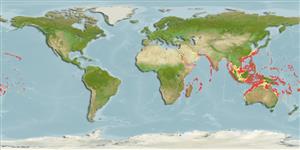Environment: milieu / climate zone / depth range / distribution range
นิเวศวิทยา
เกี่ยวกับทะเล,น้ำเค็ม เกี่ยวกับหินโสโครก; ไม่มีการอพยพย้ายถิ่น; ระดับความลึก 40 - 300 m (Ref. 89972), usually 100 - 250 m (Ref. 9710). Tropical; 30°N - 59°S, 29°E - 150°W (Ref. 5222)
Indo-Pacific: islands of the western Indian Ocean to Japan and the central Pacific. Except for a single specimen caught off the coast of Natal, South Africa, Heemstra and Randall 1993 know of no confirmed records from other continental localities of East Africa. Cephalopholis aurantia from east Africa reported by Morgans 1982 (Ref. 6448) is a misidentification of Cephalopholis nigripinnis.
ขนาด / น้ำหนัก / Age
Maturity: Lm ? range ? - ? cm
Max length : 60.0 cm TL เพศผู้/กระเทย; (Ref. 4319); common length : 30.0 cm TL เพศผู้/กระเทย; (Ref. 5450)
เงี่ยงครีบหลัง (รวม): 9; ก้านครีบอ่อนที่หาง (รวม): 14-16; เงี่ยงครีบก้น 3; ก้านครีบอ่อนที่ก้น: 8 - 9. Pale orange-red to orange-yellow or golden with red or yellow dots on head, anterodorsally on body, and on base of dorsal fin. Posterior margin of caudal fin with a pale blue edge and black submarginal line; posterior parts of dorsal and anal fins often with a narrow pale blue edge; further characterized by having ctenoid scales on body including most of abdomen; greatest body depth 2.5-3.0 in SL; rounded caudal fin; pelvic fins usually reaching anus, 1.6-2.0 in head length (Ref. 90102); head length 2.4-2.6 times in SL; interorbital area flat; rounded preopercle, finely serrate, lower edge fleshy; subopercle and interopercle serrate; scaly maxilla, reaching to or beyond vertical at rear edge of eye (Ref. 89707).
Rare species (Ref. 4319). Found on steep seaward reefs (Ref. 9710). Museum specimens are lacking. Usually at depths of 100-250 m, but can occur in shallower water (Ref. 89707). Feeds mainly on crabs (Ref. 89972). Solitary (Ref 90102).
Life cycle and mating behavior
วัยเจริญพันธุ์ | การสืบพันธุ์ | การวางไข่ | เซลสืบพันธ์ของเพศเมีย(ไข่) | ความดกของไข่ | ตัวอ่อน
Heemstra, P.C. and J.E. Randall, 1993. FAO Species Catalogue. Vol. 16. Groupers of the world (family Serranidae, subfamily Epinephelinae). An annotated and illustrated catalogue of the grouper, rockcod, hind, coral grouper and lyretail species known to date. Rome: FAO. FAO Fish. Synop. 125(16):382 p. (Ref. 5222)
IUCN Red List Status (Ref. 130435)
Threat to humans
Harmless
Human uses
การประมง: มีการค้าเพียงเล็กน้อย
ข้อมูลเพิ่มเติม
ชื่อสามัญชื่อพ้องกลไกการเผาผลาญพลังงานผู้ล่าการศึกษาเกี่ยวกับผลกระทบของสารประกอบทางเคมีที่เป็นอันตรายต่อสิ่งมีชีวิต ประชากร และสิ่งแวดล้อมการสืบพันธุ์วัยเจริญพันธุ์การวางไข่การรวมกลุ่มวางไข่ความดกของไข่เซลสืบพันธ์ของเพศเมีย(ไข่)Egg development
อ้างอิงการเพาะเลี้ยงสัตว์น้ำประวัติการเพาะเลี้ยงสัตว์น้ำสายพันธุ์พันธุศาสตร์ElectrophoresesอัตราพันธุกรรมโรคการแปรรูปNutrientsMass conversion
ผู้ร่วมมือรูปภาพหลายรูปStamps, Coins Misc.เสียงปลามีพิษ เช่น ปลาปักเป้าความเร็วรูปแบบการว่ายน้ำพื้นที่เหงือกOtolithsสมองวิสัยทัศน์
เครื่องมือ
Special reports
Download XML
แหล่งที่มาจากอินเตอร์เน็ต
Estimates based on models
Preferred temperature (Ref.
123201): 13.1 - 25, mean 19.1 °C (based on 438 cells).
Phylogenetic diversity index (Ref.
82804): PD
50 = 0.5000 [Uniqueness, from 0.5 = low to 2.0 = high].
Bayesian length-weight: a=0.01259 (0.00590 - 0.02687), b=3.04 (2.87 - 3.21), in cm total length, based on LWR estimates for this Genus-body shape (Ref.
93245).
ระดับชั้นอาหาร (Ref.
69278): 4.0 ±0.65 se; based on food items.
ความสามารถในการกลับคืนสู่ปกติ (Ref.
120179): ขนาดกลาง, เวลาต่ำสุดที่จะทำให้ประชากรเพิ่มขึ้นเป็น 2 เท่าใช้เวลา 1.4 - 4.4 ปี (Preliminary K or Fecundity.).
Fishing Vulnerability (Ref.
59153): Moderate vulnerability (44 of 100).
Nutrients (Ref.
124155): Calcium = 32.8 [17.5, 54.9] mg/100g; Iron = 0.437 [0.239, 0.833] mg/100g; Protein = 18.6 [16.7, 20.2] %; Omega3 = 0.178 [0.109, 0.295] g/100g; Selenium = 57.9 [29.9, 100.8] μg/100g; VitaminA = 82.8 [30.0, 262.9] μg/100g; Zinc = 0.748 [0.512, 1.205] mg/100g (wet weight);
